#enneagram 9
Text
New Links
I cleaned up some of the links on the website, which temporarily made the page links invalid. These are the new Enneagram links.
Enneagram 1: The Reformer
Enneagram 2: The Helper
Enneagram 3: The Achiever
Enneagram 4: The Individualist
Enneagram 5: The Investigator
Enneagram 6: The Loyalist
Enneagram 7: The Enthusiast
Enneagram 8: The Challenger
Enneagram 9: The Peacemaker
#enneagram#enneagram 1#enneagram 2#enneagram 3#enneagram 4#enneagram 5#enneagram 6#enneagram 7#enneagram 8#enneagram 9
378 notes
·
View notes
Text
"Integration is healthy and disintegration is unhealthy" is an overly simplistic, spiritual bypassing view to throw in the bin. I'm going to invite you to view it in a different way.
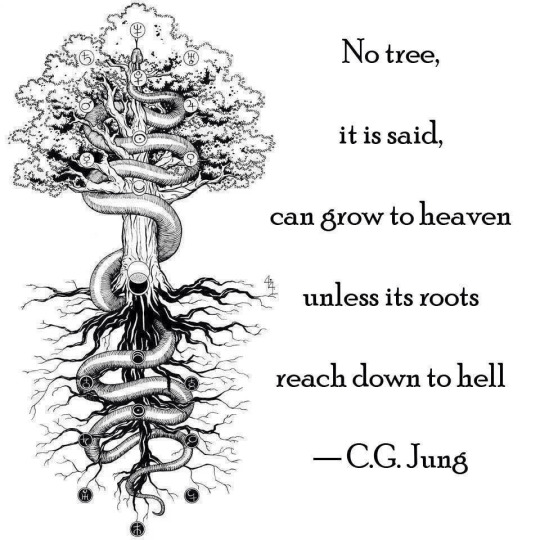

Integration is your heaven. Your light. It represents what you aspire to embody, but feel scared to embody, or cannot seem to embody no matter how hard you try. You do not have enough personal development, insight or healing to embody your integration type properly. False security is when you embody your integration type in a shallow way. You indulge in your integration type without having done enough healing to make the transformation secure, deep-rooted and long-term. You're reaching up to heaven but your roots don't reach down to hell, and so your extension is very short-lived. The excess branches you have grown to reach up to your integration type quickly die or worse, get infected, as your root system down in hell is not strong enough to sustain the tree. After periods of false security you are left with a lot of trauma, a big mess in your life, and you get pulled right back into your disintegration type's grip. You indeed can integrate in an unhealthy way... and you can also disintegrate in a healthy way. Keep reading.
Disintegration is your hell. It represents your natural stress response, your toxic coping mechanism, the thing you just really hate in yourself and in other people, your default way of overcompensating for your core type's missing pieces, your darkness. Inside your disintegration type is a wealth of secrets and wisdom that you need to uncover, including your wounded inner child. When we analyze our disintegration type and our own personal disintegration experiences, we learn a lot about ourselves. We can only learn what we are missing and what we need to work on from our disintegration type, not from our integration type. Healthy disintegration provides us the necessary foundation that we need in order to reach up towards our integration type. Disintegration is not something to be resisted the same way that cleaning your room and doing exercise is not something to be resisted just because it doesn't feel good. Conscious Disintegration is an essential part of shadow work. It is what Carl Jung would call "making the unconscious conscious".
-----
Integration and disintegration are definitely not the same. But they are also not black and white, "one is good and the other is bad". If you view it this way you are bound to bypass your necessary shadow work and end up in a cycle of false security and extreme disintegration.
#enneagram#enneagram 1#enneagram 2#enneagram 3#enneagram 4#enneagram 5#enneagram 6#enneagram 7#enneagram 8#enneagram 9#shadow work#carl jung#personality theory#typology#integration#disintegration
162 notes
·
View notes
Text
Connectinon Between Childhood Trauma and Enneagram
I've decided to share some of the stuff I learned about the childhood experience of all Enneagram types, and how this experience shapes us into a certain type. All this is based on some of my observations and studies plus backed up with some info from the books: Personality Types: Using the Enneagram for Self-Discovery by Don Richard Riso & Russ Hudon and The Enneagram Guide to Waking Up by Beatrice Chestnut.
And do keep in mind that it’s just a general pattern and observation - while it’s a lot more common for a certain type to have such a childhood experince, nothing is set in stone.
Type 1
A person could have been shaped into a One based on the experience from their early childhood where they had strict and controlling parents, which from early childhood showed the little One that they have to be responsible person, that is more mature than their peers:
Early in life, One had a painful experience of feeling criticized. When this happened, he felt pressured to conform to others’ standards of good behavior. One unconsciously tried to cope with the pain of feeling judged and punished by proactively monitoring and criticizing himself before others had a chance to. He internalized the standards others applied to him and tried to be good and do the right thing all the time. He began to feel that he had to be perfect to be seen as worthy and that he had to work hard to control himself in order to be “good.”
From: Enneagram Guide to Waking Up by Beatrice Chestnut.
Alternatively, One could have had Incompetent, naive, and/or immature parents, which showed the little 1 that they are incapable of taking care of them, so this child had to grow up too early, and become the “adult one” themselves. Type One is part of the Frustration triad, which was dissatisfied with their parental figures. They could also have been frustrated with too many rules in the family, so they developed their own vision of how things should be:
The disconnection from the protective figure, and what that person symbolized, was of central importance to the development of the superego: these children felt that they could not rely on the structure and guidelines provided by their family of origin. They may have experienced the rules of the family as arbitrary and unfair, or too strict, or too unstable. Whatever the particulars, Ones were dissatisfied and frustrated with the structure and limits that they received from the protective-figure and so felt that they had to develop their own guidelines.
From: Personality Types: Using the Enneagram for Self-Discovery by Don Richard Riso & Russ Hudon.
Type 2
All the attention and focus of type Two goes towards love and care because, as children, they felt unloved, not needed and uncared about (which is more of the case with an unhealthy childhood experience).
As Two grew up, she experienced bad feelings when some of her needs weren’t met by the people around her. Sometimes when she was hungry, no one came to feed her. Sometimes when she got hurt, no one realized she needed comfort. And when she felt her deep need for love, she often felt that she did not receive it. Two tried to find the love she needed by expressing love for the people around her. She tried to get them to take care of her by taking care of them. If she was very pleasing, helpful, and supportive of others, she thought, they would want to be very pleasing, helpful, and supportive of her. They might remember to take care of her. To get the love she needed so much, Two found herself doing all she could to please the people in her world.
From: Enneagram Guide to Waking Up by Beatrice Chestnut.
Alternatively, type Twos could have been slightly more connected to the protective figure, as opposed to the more nurturing one, or they may have grown up without a nurturing figure altogether. So Twos learned to take up on a role of a nurturing figure themselves.
Since the orientation is toward the protective figure who represents the qualities associated with patriarchy— authority, structure, discipline, guiding the child in the ways of the world—the child began to identify with the complementary, matriarchal role. Young Twos learned to become "little nurturers" as a way of gaining safety and security in the family system. In other words, they believed that if they could nurture others in their family sufficiently, they could win the affection and protection of the protective-figure. This relationship with the protective figure sets the stage for a similar orientation toward everyone who can give Twos the love they want.
From: Personality Types: Using the Enneagram for Self-Discovery by Don Richard Riso & Russ Hudon.
Type 3
The strong impulse to achieve, be better and be praised that type Three craves stems from their childhood experience, where they were only (or mostly) loved and given attention when they somehow stood out from their peers, particularly for their accomplishments.
Three saw that she was praised for what she did, not for who she was. Everyone around her got very excited and happy when she successfully completed her homework, or did a trick in gymnastics, or won a game. But when she expressed her true emotions, when she felt sad or disappointed or hurt, no one paid any attention to her at all. She felt lonely and scared when no one recognized her or cared about what she expressed from her heart. People seemed to like her when she accomplished things; but they acted as if she didn’t exist when she was just being herself. Three found a way to make sure that she wouldn’t feel alone or fearful anymore. She discovered that she had the ability to sense what people valued and then magically turn herself into exactly that.
From: Enneagram Guide to Waking Up by Beatrice Chestnut.
Alternatively, Threes are also part of an Attachment triad because they were very connected to the mother (or the mother figure) - basically, anyone that praises and admires them, showers them with gifts and compliments, and they got so attached to this person from early childhood that they learned to act in a way that will receive this positive affirmation.
As young children, Threes were connected to the nurturing figure, the person who in their early development mirrored them, cared for them, and provided affection and a sense of the Three's personal value. This person is usually the Three's mother or a mother-substitute, but not always. In some cases, the mother may have been largely absent, physically or emotionally, and it fell upon the father or a sibling to nurture the baby. In other cases, a nanny or grandparent may have fulfilled this role. In any case, it is important to understand that the nurturing figure is the person who cared for the child and who provided mirroring. In their formative years, Threes learn to tune in to the desires and hopes of their nurturing-figure. As adults, Threes continue to play out this pattern learned in early childhood. They seek out people whom they admire and esteem to give them validation and admiration.
From: Personality Types: Using the Enneagram for Self-Discovery by Don Richard Riso & Russ Hudon.
Type 4
As young children, type Four felt a loss of connection with their parents. Similar to type Two, they felt that they were unloved and not needed, but unlike Twos that were ambivalent to their parental figures, Fours felt completely disconnected from them. Moreover, type Fours started to believe (or were even directly told) that the parents are no longer connected and appreciate them because of the Four's fault, that they are somehow to blame. Maybe they were a child of a younger couple that has the kid too early and then blamed the Four, maybe claiming that them being born ruined all the opportunities for these now-parents. Four could have also started to think on their own that since the parents no longer like and care for them as much, then there must be something wrong with them, that they are not like everyone else.
Fours are disconnected from both parents. As children, they did not identify with either their mothers or their fathers. ("I am not like my mother; I am not like my father.") They may have had either unhappy or solitary childhoods as a result of their parents' marital problems, divorce, illness, or simply because of personality conflicts within the family.
From: Personality Types: Using the Enneagram for Self-Discovery by Don Richard Riso & Russ Hudon.
Even more often there could have been a sibling rivalry in the family, where Four was the older sibling, and all the attention was given to their younger sister(s)/brother(s) while they felt abandoned, so they felt the need to somehow stand out to be noticed.
A baby was born. It was as if Four’s perfect world ended. No longer was she the center of her parents’ attention. No longer was she the most special child in the world. When she wanted someone to play with or a hug, everyone was busy taking care of the baby. She felt unimportant, alone, and ordinary. Four made sense of this terrible new situation by believing that she must have done something wrong to cause the loss of connection with her parents. After all, they didn’t seem to care about her the way they did before. It must have been her fault. They must have discovered there was something wrong with her. This new baby must somehow be better. What other explanation could there be? Four’s new way of thinking caused her some pain and distress, but gradually she got used to feeling bad—and sad. And, she reasoned, if it was her fault that she had lost the connection she had once felt—maybe that meant she could do something to make things right. Maybe she could somehow make a connection with others and the world again by showing everyone how special she was— or by making them see how much she was suffering by acknowledging that she wasn’t as special as she had thought. Over time, Four tried different ways to rebuild the connection she had lost. She tried to get people to see her as special again.
From: Enneagram Guide to Waking Up by Beatrice Chestnut.
Type 5
In their early childhood, Type Fives felt an almost smothering influence of their parents: they could have been way too involved in the lives of their child, too clingy, giving them little to no privacy, and constantly invading their personal space, leaving too little room for Fives to withdraw and be left alone. That is what developed a Withdrawal stance in type Fives, as they started to realize that if they will let other people way too close, that they start to get too overly involved in other people’s lives they will also start to lose that independence and will again be overwhelmed with people’s attention and demands. So Fives learned to not only minimize their needs but to also avoid investing in a lot of relationships.
When she was young, Five tried to create true heartfelt connections with people. However, those people had a tendency to invade her space when she felt like being alone. And then they weren’t around when she really wanted them to be. Both intrusion and unavailability were a cause of constant concern for Five, which made it hard for her to know what to do to relate well to others, especially when she felt intruded upon or neglected. She secretly felt inadequate and different from others. Trying to find ways to connect with them just frustrated her. Again and again, people either left her when she felt she needed them or they didn’t allow her to be alone enough. As time went on, Five finally gave up and disconnected more and more from others and from her feelings. Five found she felt calm and comfortable when she spent time by herself.
From: Enneagram Guide to Waking Up by Beatrice Chestnut.
Not only that but too much care and attention from parents, and their clinginess made Five think that they are caring so much because the parents think that Five is incompetent and incapable to deal with their own problems, and Fives also start to believe that as well. So they started to gather knowledge and hone skills to be safe in the world and to be able to deal with problems that could arise.
Type 6
Since their early childhood Sixes were either were constantly told that the world is a dangerous place and people are unreliable, to the point that parents almost instilled fear in them: “the monsters are hiding under your bed”, “I will tell a police to come to get you if you will behave inappropriately” etc or the Sixes experienced a traumatic or life-threatening event which made them think that they always have to be careful, that the wolves are after them, things can easily go wrong, so the Six child always has to be cautious.
As Six grew up, she had a few experiences that made her feel afraid. Her mother once forgot to pick her up at school. She was frightened by a movie that showed people being killed. She started noticing all the things that could go wrong and learned that sometimes bad things happened. The world started seeming more dangerous and more threatening to her. Six became paralyzed with fear and doubt. She wanted to feel safe and carefree as she had before, but that didn’t seem possible. The world seemed like a fundamentally dangerous place. The only thing that seemed to help was to imagine all the bad things that could happen so that she could make sure they didn’t. But any feeling of safety that brought her was only temporary.
From: Enneagram Guide to Waking Up by Beatrice Chestnut.
Alternatively, Sixes may also have a strong and protective father figure, on which they relied the most, who protected them. So losing the support of such a strong father figure and being left alone in a scary world was especially terrifying for Sixes, hence why they became the Attachment type that seeks to build connections to feel safer, like with their protective figure from childhood.
As the result of their formative experiences, Sixes became connected with their protective-figures. The protective-figure was the adult in the child's early environment who provided guidelines, structure, and sometimes discipline. This was the person who occupied the traditional patriarchal position in the family. Most often this was their fathers, or a father figure, such as a grandfather or teacher, but in many cases the mother or an older sibling may actually be the protective-figure. As children, Sixes wanted the security of approval by their protective-figures, and felt anxious if they did not receive it. As they grew up, their connection with their protective-figure shifted to an identification with substitutes for this person, such as civil authorities or belief systems from which they could obtain security.
From: Personality Types: Using the Enneagram for Self-Discovery by Don Richard Riso & Russ Hudon.
Type 7
From early childhood, Sevens felt rejected by the parental figures the same way Fours may have, but while Fours felt that parents didn’t connect to them because there is something wrong with them, that the Four is somehow to blame, Sevens felt that parents were way too busy with their life and work to pay as much attention to Sevens as they may have wanted. Sometimes, parents may have even brushed them off when the Seven was in need or pain, or the parent’s indifference to the child caused the Seven that pain, so they learned to avoid the hurtful feelings as much as possible.
One day, when Seven was paying close attention to a bee that was walking on his leg, it stung him! He burst into tears and looked around for someone to comfort him. He tried to tell his father about it and perhaps receive some comfort, but his father was angry about something and told him to “go away.” So he went to his mother, but she was busy doing something and said she “didn’t have time” to hear about something so insignificant. These responses made Seven feel even more pain—almost more than he could handle.
Seven hadn’t had much experience with pain, and he didn’t like it. So, to get away from these unpleasant sensations, he retreated into his own imagination. He started thinking about things that made him excited—watching clouds as they passed through the sky or playing with his best friend. In fact, Seven found that he was good at imagining fun and interesting things. As time went on, he became adept at diverting his attention to these thoughts whenever any kind of pain threatened him.
From: Enneagram Guide to Waking Up by Beatrice Chestnut.
Alternatively, Sevens may have encountered a serious trauma as a kid, that made them feel like they would be deprived of something, so to avoid fear of being deprived they started to adopt a more gluttonous attitude, fearing that what they need to survive may be taken away from them.
Some other childhood deprivation, such as poverty, war, being orphaned, or a long illness, may have shaken their expectation that the good things of life would be given to them. There may have been an absence of the nurturing-figure at a critical stage, or some accident that shook the child's faith that he or she would be adequately supported. It may also be that Sevens naturally need a great deal of contact and stimulation which may be more than the nurturing-figure can provide. Thus, for whatever reasons, the fear of deprivation becomes the fundamental motivation for this personality type.
From: Personality Types: Using the Enneagram for Self-Discovery by Don Richard Riso & Russ Hudon.
Type 8
Type Eight’s childhood experience may resemble one of type Six, where they felt or made believe that the world is dangerous, and people are out to get them. However while Sixes developed a more neurotic and cautious stance, thinking that they will be safe if they have someone to rely on or an ideology/law to follow, type Eight decided that they will be safe if they become strong and could face these challenges themselves, without relying on anyone. Moreover, while Sixes may have had a protective figure that could defend them when needed, Eights felt no protection from their parental figures, or sometimes these parental figures may have been abusive themselves.
Early in life, Eight had an experience in which she needed protection and there was no one there to take care of her. Sometimes there were things she just couldn’t do by herself, even though she was bright and capable for someone so young. The people in her life that were bigger than she was didn’t seem to notice when she needed to be cared for, listened to, or fed. And a few times, when one of the older kids hurt her, no one saw that she was little and needed protection. So Eight learned—the hard way—that she had to take care of herself. If no one else was going to do it, it would have to be her job. She would have to get big—fast! (Too fast.) She would have to be strong. She would have to be powerful, even though she was still small. Sometimes people around her fought, and they didn’t notice she was scared. So she would have to be fearless, in addition to being big, and strong, and powerful.
From: Enneagram Guide to Waking Up by Beatrice Chestnut.
Also, Eight could have had the opposite childhood experience from Twos, where Twos had a stronger protective figure so they had to become the nurturer, Eights had a stronger nurturing figure, so they decided that they need to become the protective figure themselves.
Eights learned that they could maintain some kind of connection with the nurturing-figure and fit into the family system by functioning in a role that was complementary to the nurturing-figure. The nurturing-figure represented (and therefore "owned") the qualities associated with motherhood: warmth, caring, nurturance, approval, gentleness, and sensitivity. Thus, the Eight identified with the complementary patriarchal role, and learned that the best way to get some sense of value, affection, and nurturance was to be "the strong one," the little protector, the one that others turn to for strength and guidance, especially in a crisis.
From: Personality Types: Using the Enneagram for Self-Discovery by Don Richard Riso & Russ Hudon.
Type 9
At some point in their childhood, Nines felt that their desires, wishes and opinions are not important or listened to. When they tried to express what they wanted, their parents may have shut that desire off, bruising it aside, or choosing for them under the pretence that they know better. At first, Nine could have protested against that, but when they started to understand that the more they protest the more arguments and conflicts it will cause, damaging their relationship with the parents, the more they began thinking that maybe what they want is not worth all the drama and discord that disrupts their inner peace. Instead, it was better to go along with what others wanted, and find comfort in other parts of life.
Nine woke up one day feeling alone and disconnected. He felt frustrated at having been left by himself and wanted to register a protest against whoever had pushed him out on his own. But this made him even more uncomfortable. There were others nearby, but they seemed somehow distant. This new sense of being separate felt lonely and scary. If he was no longer connected to the world around him, how could he feel any sense of belonging? When Nine tried to complain about this new and disturbing situation in order to re-establish his connection with others, no one would listen. Those around him spoke louder and had more important things to say. They knew what they wanted and argued to get it. They didn’t seem bothered by the fact that they were separate—and that their arguing made them more so. They didn’t seem to care what Nine was saying. He tried speaking louder and protesting more, but no one paid attention. After a while, he simply gave up. If they weren’t going to listen, he might as well go back to sleep. At least there was comfort in sleep.
From: Enneagram Guide to Waking Up by Beatrice Chestnut.
Alternatively, Nines could have lived in a very intense or unhealthy environment, that damaged them emotionally. So in order to keep their peace and sanity in one piece, they learned to numb their feelings, to protect themselves.
If their early childhood was torn by strife and dysfunction, holding all of the painful and conflicted feelings and messages inside them was almost intolerable, so average to unhealthy Nines learned to dissociate—to remove themselves from the immediacy of their feelings and thoughts so that the inner turmoil they absorbed did not overwhelm them. At the same time, they learned to tune out the conflicts and pain of the external environment, a strategy familiar to many children. This is like the young person who blocks out the sound of her parents fighting in another room by singing a song to herself or remembering happier time.
From: Personality Types: Using the Enneagram for Self-Discovery by Don Richard Riso & Russ Hudon.
#enneagram#enneagram 1#enneagram 2#enneagram 3#enneagram 4#enneagram 5#enneagram 6#enneagram 7#enneagram 8#enneagram 9
537 notes
·
View notes
Text
All Enneagram Guides
Gut Types (9-8-1)
https://www.tumblr.com/blueopinions49/714684054949298176/understanding-type-9?source=share
https://www.tumblr.com/blueopinions49/713776928726958080/understanding-type-8?source=share
https://www.tumblr.com/blueopinions49/715329872464150528/understanding-type-1?source=share
Head Types (7-6-5)
https://www.tumblr.com/blueopinions49/713157696877199360/understanding-type-7?source=share
https://www.tumblr.com/blueopinions49/712508568147984384/understanding-type-6?source=share
https://www.tumblr.com/blueopinions49/712065601858895872/understanding-type-5?source=share
Heart Types (4-3-2)
https://www.tumblr.com/blueopinions49/710605851536326656/understanding-type-4-pt-1?source=share
https://www.tumblr.com/blueopinions49/711239964250324992/introduction-this-is-a-rantinformative-post-on?source=share
https://www.tumblr.com/blueopinions49/710152882517884928/understanding-type-3?source=share
https://www.tumblr.com/blueopinions49/708805690950565888/understanding-type-2?source=share
“The Instinctual Drives and The Enneagram”- John Lukovich 2021
#mbti#zodiac#zodic signs#personality types#16 personalities#ennegram#mbti personality types#enneagram#personality typology#typology#mbti thoughts#mbti things#enneagram 9#enneagram 5#enneagram 4#enneagram 6#enneatypes#enneagram 7#enneagram 3#enneagram 1#enneagram 2#enneagram 8#enneagram 1w2#2w3#3w4#4w5#5w6#6w5#7w8#8w7
112 notes
·
View notes
Text
A poem for each EnneaType.
By Melissa Kircher, transcribed from @enneagrampaths.
A poem for EnneaType 1
and failure
isn't failing
it's actually an event
creating space
for new life
to burst into wild reality
A poem for EnneaType 2
the soot and ash
a charcoal facade
behind which
two eyes, glowing
watch out
she burns hot
A poem for EnneaType 3
I think poetry
might be inside you
the words there
ready to tumble out
I think the stars
shine only for you tonight
and the earth turns
to keep you on it
A poem for EnneaType 4
if I let out the pain
I said
it will shatter galaxies
that's fine
she replied
I made lots of them
you can break a few
A poem for EnneaType 5
stay
anchor in the depths
every drop in the ocean
sings for your presence
here. now.
A poem for EnneaType 6
opening like petals
rooted like pines
woven back whole
one thread at a time
stretching up, out, down
new rhythms like rhyme
mothered soul tender
finding child eyes
dancing forest wild
tasting deep like prophets wise
A poem for EnneaType 7
the sun hanging by a thread
details that weigh mountains
I want to find you again
the girl in the tutu that sparkled
and when I do
pulling you into my lap
I'll whisper
you already knew
the wisdom of the Universe
A poem for EnneaType 8
strong is two feet solid
in the soil
toes curled into the loam
strong is letting pain
sweep through your branches
and losing some leaves
strong is allowing the shadows to
surround you
to change you
and then
gently letting them pass
A poem for EnneaType 9
what could I do?
these were my people
so I went
I entered their anguish
I felt their relation
and then I understood
the spectrum of my own heart
#poetry#melissa kircher#enneagram#enneagram 1#enneagram 2#enneagram 3#enneagram 4#enneagram 5#enneagram 6#enneagram 7#enneagram 8#enneagram 9
67 notes
·
View notes
Text
Enneagram Meems - prt 2

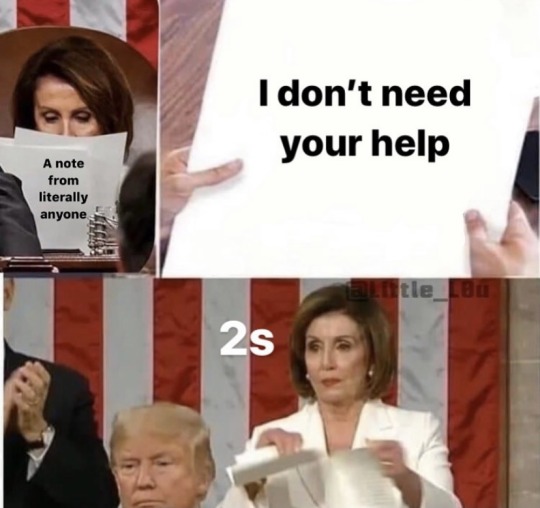
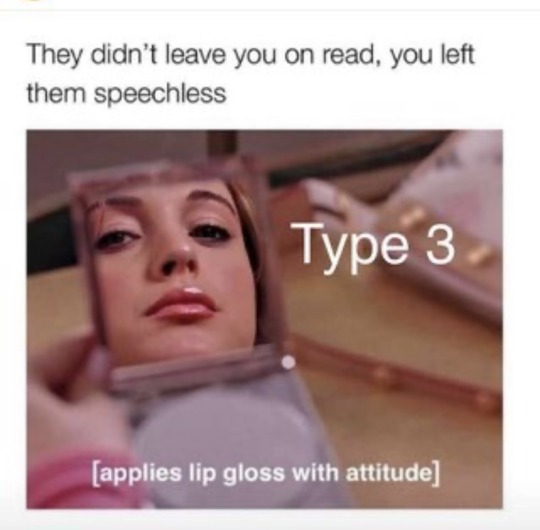
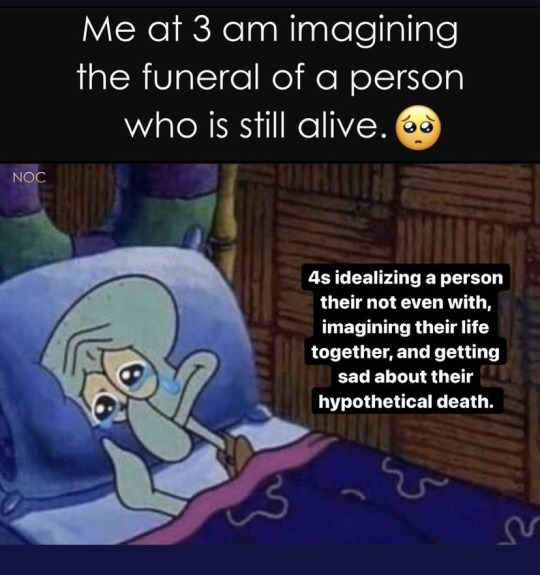

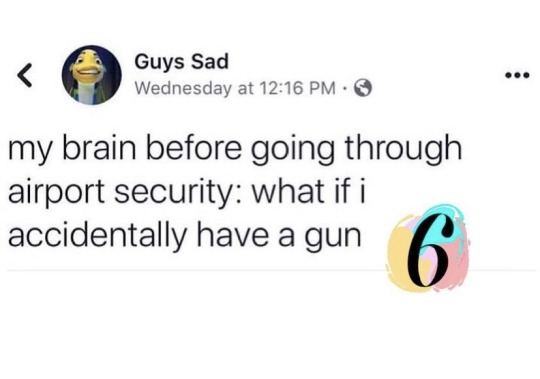
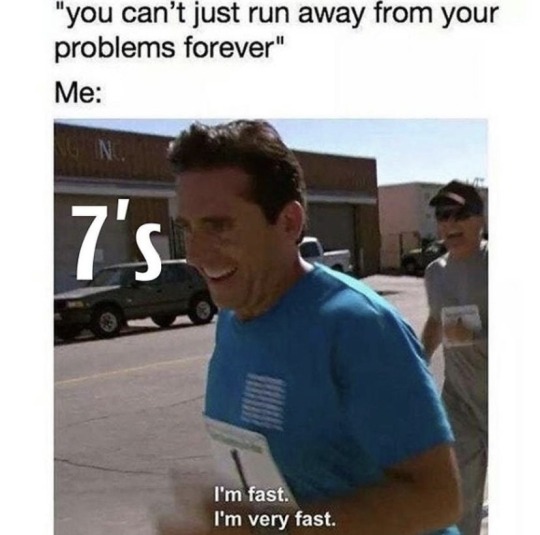


#memes#funny#laugh#haha#enneagram#enneagram memes#enneagram 1#enneagram 2#enneagram 3#enneagram 4#enneagram 5#enneagram 6#enneagram 7#enneagram 8#enneagram 9#1w2#1w9#2w1#2w3#3w2#3w4#4w3#4w5#5w4#5w6#6w7#7w6#7w8#8w7#8w9
94 notes
·
View notes
Text

#enneagram#enneatypes#enneagram 1#enneagram 2#enneagram 3#enneagram 4#enneagram 5#enneagram 6#enneagram 7#enneagram 8#enneagram 9
226 notes
·
View notes
Text

CRITICAL ROLE: BELL'S HELLS (2021–) ENNEAGRAM TYPES ★
Orym of the Air Ashari – Type 9(w1): The Negotiator
Nines are accepting, trusting, and stable. They are usually creative, empathetic, optimistic, reassuring, and supportive, but can also be too willing to go along with others to keep the peace. They can bring people together and heal conflicts, but they can also be complacent. They typically have problems with inertia.
Nines are devoted to the quest for internal and external peace for themselves and for others. They work to maintain their peace of mind just as they work to establish peace and harmony in their world. Nines can have the strength of eights, the sense of fun and adventure of sevens, the dutifulness of sixes, the intellectualism of fives, the creativity of fours, the attractiveness of threes, the generosity of twos, and the idealism of ones.
9w1s can easily come to conclusions and make decisions: if something isn’t good, they will let people know. They’re easygoing and kind, and usually know exactly what to say to calm and embrace others. Their strengths come from their ability to be open-hearted and open-minded: they don’t feel the need to always be right, but they always want to be fair and do the right thing. They give themselves to the world to make it a better place.
Sources: 1 2
#orym of the air ashari#orym#halfling#fighter#bell's hells#critical role#dungeons and dragons#dnd#d&d#enneagram#enneagram type#enneagram type 9#enneagram type nine#enneagram 9#enneagram nine#type 9#type nine#9#nine#art#digital art#photoshop#graphic design#graphic#artists on tumblr#artist on tumblr#annemarieyeretzian
39 notes
·
View notes
Text
Enneagram notes list
Just some enneagram notes. Not an expert. May change later.
___
Enneagram system
Some sources
Enneagram types overview/basics
1 | 2 | 3 | 4 | 5 | 6 | 7 | 8 | 9
___
Other lists:
MBTI Notes
Kpop idol typology
#enneagram#enneagram notes#enneagram types#enneagram 1#enneagram 2#enneagram 3#enneagram 4#enneagram 5#enneagram 6#enneagram 7#enneagram 8#enneagram 9#typology#typology notes#enneagram system#masterlist
37 notes
·
View notes
Text
The thing about nines is that they will never seem mad. And that's because they never "feel" mad. They suppress it until they don't even register it.
But once you unlock all that anger (and that takes a lot), you do not want to stand in their way. Nines heal and comfort people. It's what they do best. But in order to know how to build you up, they have to know how to destroy you, too.
It goes against every one of their morals to do so. But if you push them past their limit, they will send you to hell on earth.
Watch out for nines. They may seem mellow, but they're pretty intense when it gets down to it.
#enneagram#enneagram 9#enneagram nine#type nine#let's talk more about nine anger#they're in the anger triad but everyone just wants to talk about their passion#which is sleeping and procrastinating#which is true#but it bugs me#we're not all dreamers#we can just as easily become assassins#we'll hate every second of it#it's not natural for us to do that#but#if we have to#then we will
23 notes
·
View notes
Text
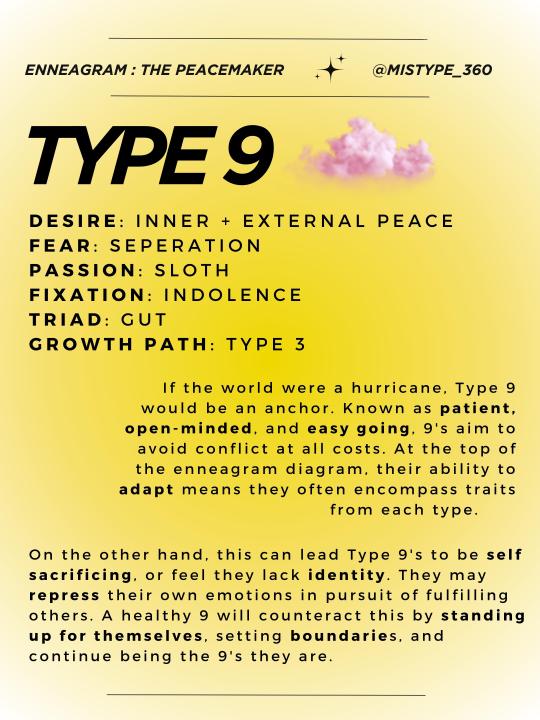
15 notes
·
View notes
Text









Enneagram 9 Proberbs (1-9)— Jenny Slate, enneagramer.com, Maurice Merleau-Ponty, Mary Oliver, Jackson Browne, Beatrice Chestnut, Hannah Haifsch, Michael Cunningham , Fiona Apple
#i’ve gotten really into the enneagram if you can’t tell#9’s are like. personality typing system????!!?!?? REAL SHIT.#enneagram#9posting#enneagram 9#social 9#9w1#web weaving
156 notes
·
View notes
Text
9s
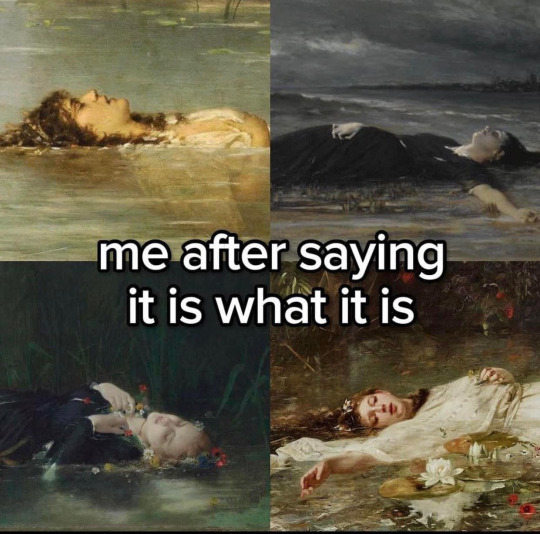
#enneagram 9#9w8#9w1#type 9#typology#enneagram#personality theory#8w9#1w9#withdrawn triad#optimist triad#positive triad#attachment triad
95 notes
·
View notes
Text
Enneagram Types of the PJO original trio
These are the same in the books and the show but I'm going to use the show as evidence because things are more obvious in it (From an Enneagram 8w9, which is what everyone is typing Percy as)
Percy - Enneagram 6 - Desires stability
wants to belong
surrounds himself with people that he trusts (Grover, Sally, Luke)
lashes out at the people he doesn't trust (Annabeth, or even Nancy and Gabe)
a lot of people think he's an 8, but 8s are all about projecting strength, and if he were about that he would've got Annabeth back for using him in Capture the Flag because she made him look SO WEAK. When he chose her for the quest, he kept bringing up how she might betray him, aka she's a threat to his stability. Also, when he gets in trouble for pushing Nancy, he would've argued his way out of expulsion, but he holds back because he doesn't trust the school to understand
Grover - Enneagram 9 - Desires peace
always getting along with everyone
UM THE CONSENSUS SONG
very very empathetic
has wing 8 qualities because he is very protective of his friends
Annabeth - Enneagram 3 - Desires worthiness
"If we call for help, we're basically saying they made a mistake in choosing us." (Percy's response to this is also proof that he isn't an 8 bc he would've told her she was wrong instead of accepting that someone made a mistake)
has waited for a quest FOREVER because she has to prove herself to her mom, who has made her feel like she's unworthy of her attention and her praise, so Annabeth has to do all these things to get it
"the most formidable demigod child", she's worked VERY hard to build that reputation
used Percy to win Capture the Flag, once again proving herself as greater than she really thinks she is
If you need more proof, these numbers are all connected. In stress, 6s take on the negative traits of 3s, so Percy would become competitive ("I was thinking of pushing Nancy in the nearest dumpster."). In stress, 3s take on the negative traits of 9s, so Annabeth would become apathetic, which shows in her reaction to Percy suggesting they leave her hat at Medusa's. It's such a crucial situation and it's very stressful, so she doesn't say anything about it because she's afraid it will steer them away from her goal. In stress, 9s take on the negative traits of 6, so Grover becomes worrisome, which shows when he gets Percy in trouble and when Percy and Annabeth are arguing.
Anyway, those are just my thoughts :) <3
#percy jackson and the olympians#pjo tv show#pjo series#pjo disney+#percy jackson#enneagram#personality types#personality#enneagram 6#enneagram types#enneagram 3#enneagram 9
15 notes
·
View notes
Text
Understanding Type 9
An intro to enneagram 9
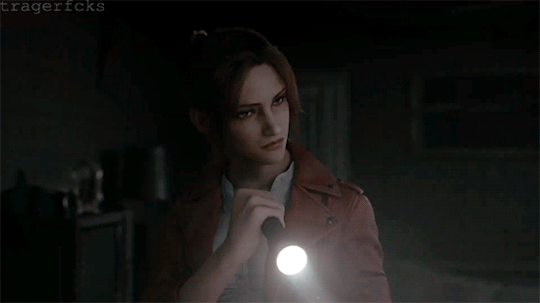
Claire Redfield (Resident Evil) ESFP 9w1 so/sx
Core Desire (Stability)-They crave a stablity in both their internal world and external world.
Vice (Sloth)- They aren't inactive individuals bur rather they will lose themselves to the haze of life in order to maintain peace.
Fixation (Indolence)- They resist anything that causes pain to them directly.
Wings
9w8 (The Advisor)- With the w8 this type is more interesting with merging with the enviorment and tends to be more in tune with the world around them. They want to fid comfort in themselves and world around them. However unlike the 9w1 they can be more apathetic to things around them. They dont have as much of problem saying no and demanding what they want from others.
9w1 (The Dreamer) - Unlike the 9w8 this subtype is more reserved socially and focuses on their own mind and place in the world rather than the enviorement around them.Unlike the 9w8 this type is more anxious and interested in creating unity with others rather than in themselves like a 9w8. They are less active than the 9w8 and will reside in others unlike the 9w8 who resides on themselves when it comes to their look for peace.
Triads- Gut (8-9-1)
They manage their anger and life through blurring lines between themselves and others often living in this haze where their internal world and external world collide.
Harmonic Triad- Positive (2-7-9)
.They handle conflict through the avoidance of them in the look for comfort and harmony.
Hornevian Triad- Withdrawn (4-5-9)
They get their needs mets through removing themselves from the equation in order to find peace and comfort.
Object Relations- Attachment (3-6-9)
They crave emotional attachment with others so they blur the lines between themselves and others.
Subtypes
Social (so)- As the counter type of 9 the subtypes counters the haze in which sp and sx 9s find themselves in. They are more grounded and interested in making connections and participating in life. They are more interest in keeping busy and focusing on groups and helping others. Due to them being a social type they want to find their place of belonging and they due this through being warm and friendy. They always find ways to figure problems out in ways that everyone gets to be happy. They can look like E3s or E2s.
Ex-Peter Parker (MARVEL COMICS) INFP 9w1 so/sx, Yoda (SW) INTP 9w8 so/sp and Padme Amidala (SW) ENFJ 9w1 so/sx
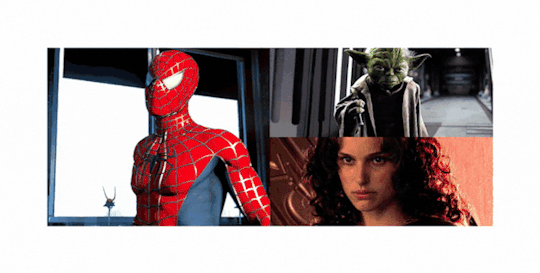
Sexual (sx)-They sx 9 ignores reality in order to merge with others emotionally. They usually due this through adapting themselves to others needs. They find their purpose in the fusion between two people adopting traits and beliefs from them. Usually they find their sense of peace and stably through complying with their desire ones needs. Will be easy going and doesnt like to cause friction between people. Due to this they can look like E4s (but less emtionallly aggressive with a need for authentic just connection) and E2s (Look for love and stability through interpersonal relationships).
Ex-Sophie Hatter (HMC) ISFJ 9w1 sx/sp, Shinji Ikari (NGE) INFP 9w1 sx/sp and Waymond Wang (EEAO) INFP 9w1 sx/so.
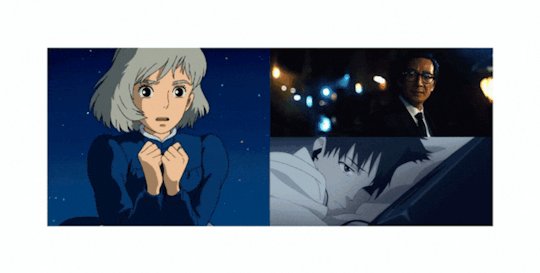
Self-Preservation (sp)- The sp 9 find comfort in the meet of physical needs they look for a place in which they can find comfort and stabitlity. They desire the calmness of everyday life and submit themselves through a routine in which they can find comfort. Unlike the sx 9 who numb their existence through the need for interpersonal relationship. The sp 9 does this through loosing through day to day life and fall into the numbness of casual life.They want to spend their time alone more compared to other 9s. They can look like E8s.
Ex-Cheryl “Heather” Mason (SH) ISFP 9w8 sp/sx, Harry Potter ISFP 9w8 sp/sx and Rue Bennett (Euphoria) ISTP 9w8 sp/sx
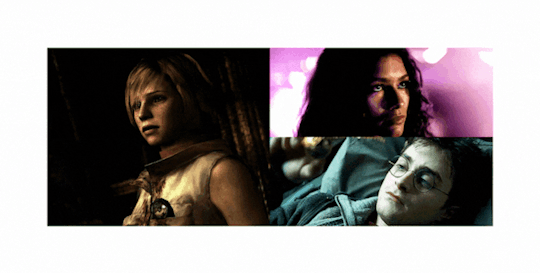
Movements
Moves to 3
Positive: gain energy and productivity, become more focused, gain confidence, live more for themselves rather than through others
Negative: take on too much, seek validation from others for accomplishments rather than doing things for themselves
9 MOVES TO 6
Positive: become more outspoken and direct about their thoughts, become more realistic
Negative: increased anxiety, self-doubting, anxiety, and rigidity; become even more passive and inactive in this paralysis
NOTE
-Sorry for the low content posting im starting finals this weeks and ive studying like crazy. In late May and summer I'll try to post more frequently. Let me know what you guys would like to see next.
#mbti#zodiac#zodic signs#personality types#16 personalities#ennegram#mbti personality types#enneagram#enfj#esfp#mbti intp#mbti infp#enneagram 9#9w1#9w8#padme amidala#spider man#peter parker#howlsophie#howls moving castle#sophie hatter#rue bennett#cheryl mason#silent hill#euphoria#harry potter#mbti isfp#infp personality#intp personality#isfp characters
87 notes
·
View notes
Text

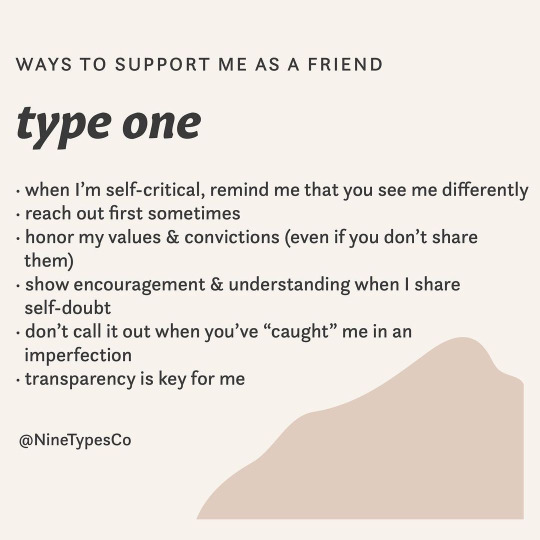
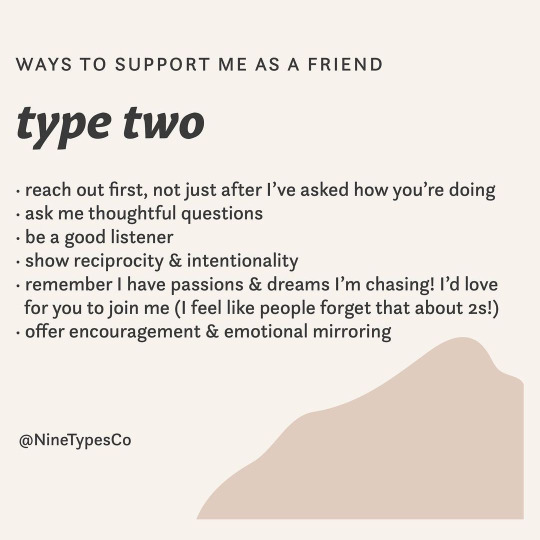
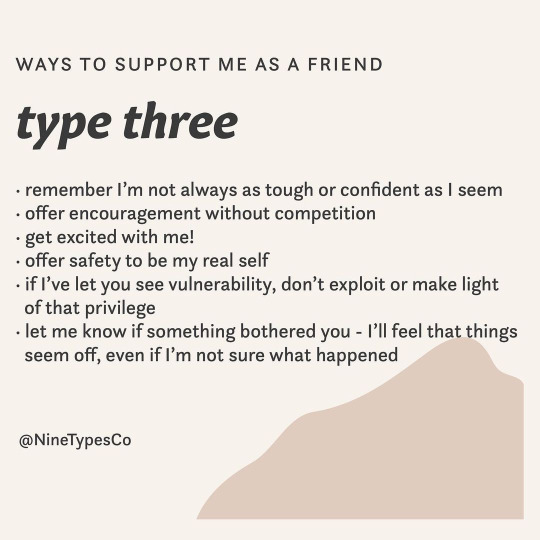


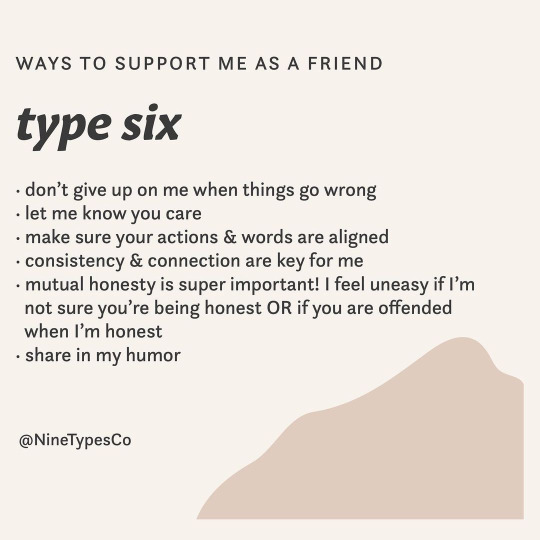


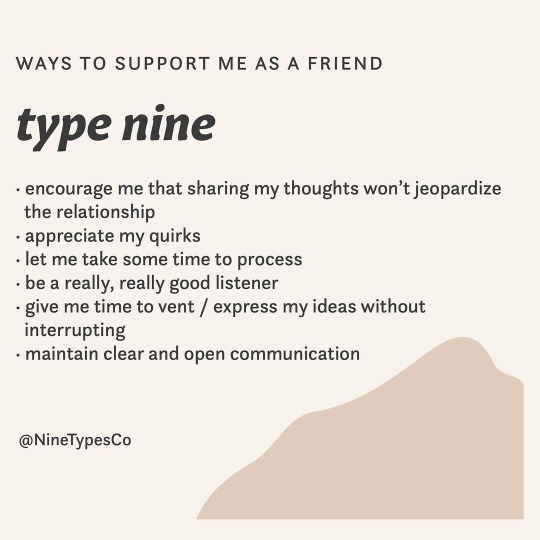
Ways to support me in a friendship, by Enneagram type. From NineTypesCo by Steph Barron Hall.
#steph barron hall#ninetypesco#enneagram#enneagram 1#enneagram 2#enneagram 3#enneagram 4#enneagram 5#enneagram 6#enneagram 7#enneagram 8#enneagram 9
12 notes
·
View notes